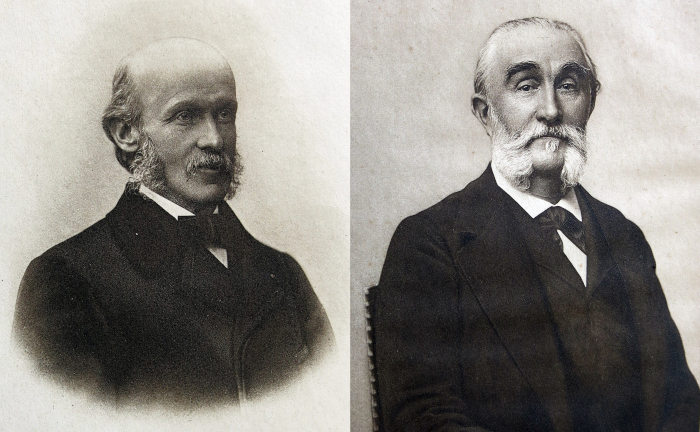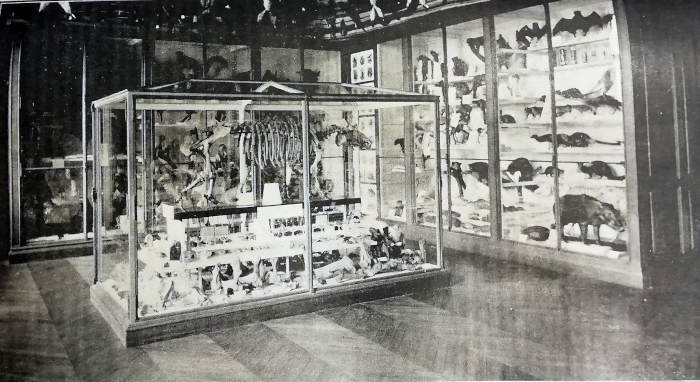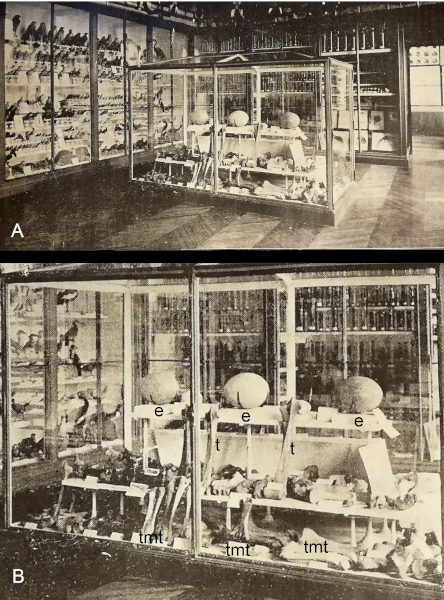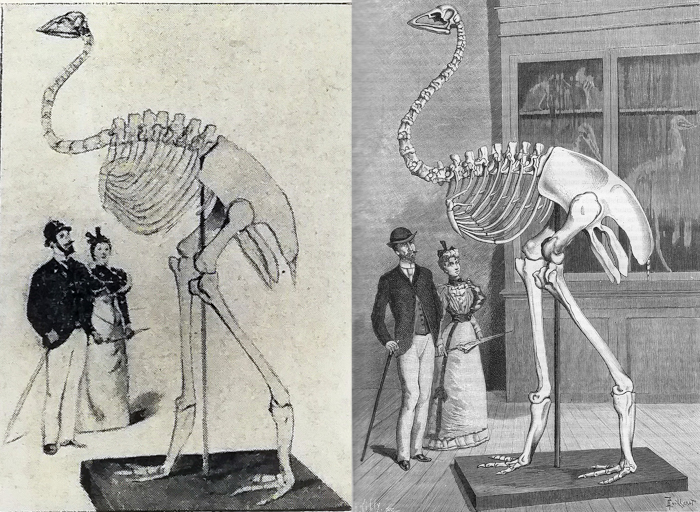The first published photograph of Aepyornis eggs? Alphonse Milne-Edwards, Alfred Grandidier and the Madagascar exhibition (1895)
La première publication d'une photographie d'oeufs d'Aepyornis? Alphonse Milne-Edwards, Alfred Grandidier et l'exposition de Madagascar (1895)
- Eric Buffetaut
|
The earliest published photograph of Aepyornis eggs seems to be an illustration in a paper by Alphonse Milne-Edwards published in 1895. It shows three eggs on display at an exhibition about the natural history of Madagascar at the Paris Natural History Museum. The exhibition was organised by Milne-Edwards, with the help of the explorer Alfred Grandidier, to foster interest in Madagascar among the public at a time when the French army was invading the island. The Aepyornis eggs were part of an undisguised effort of colonial propaganda. Mots clés: Aepyornis - eggs - Madagascar - exhibition - colonial propaganda La plus ancienne photographie d'oeufs d'Aepyornis paraît être une illustration d'un article d'Alphonse Milne-Edwards publiée en 1895. Elle monte trois œufs présentés à une exposition sur l'histoire naturelle de Madagascar au Muséum d'histoire naturelle de Paris. Cette exposition était organisée par Milne-Edwards, avec l'aide de l'explorateur Alfred Grandidier, pour développer l'intérêt pour Madagascar dans le grand public à un moment où l'armée française envahissait l'île. Les œufs d'Aepyornis faisaient partie d'un effort non déguisé de propagande coloniale. Keywords : Aepyornis - oeufs - Madagascar - exposition - propagande coloniale |
Aepyornis eggs and bones at the Madagascar exhibition
|
The illustration of Milne-Edwards’s paper on Madagascan animals including three Aepyornis eggs, on display at the 1895 Madagascar exhibition at the Paris Natural History Museum, seems to be the earliest published photograph of such eggs. One of the main aims of the exhibition clearly was to foster interest in Madagascar among the French public for colonial purposes, at a time when the French army was invading the island. Because of their huge size, Aepyornis eggs attracted public attention and natural history museums were keen to acquire specimens. They must have been among the most spectacular items in the Madagascar exhibition. No attempt was made at that time to mount a composite Aepyornis skeleton using the bones available in Paris; the first mounted Aepyornis skeleton was displayed at the British Museum (Natural History) in 1897 (Andrews, 1897 – the paper includes a halftone showing the skeleton,, but the other illustrations are drawings). It was not until 1913 that a complete composite skeleton was mounted at the Paris Natural History Museum in 1913 (Monnier, 1913). Milne-Edwards's paper does include a rather crude figure showing an Aepyornis skeleton (Fig. 4), but it is clearly redrawn from a better drawing in a popular paper by Oustalet (1894), which is an artist's vision of what an Aepyornis skeleton may have been like. The anonymous author of the short piece about the Madagascar exhibition in the Bulletin du Comité de Madagascar gave only a cursory list of the zoological specimens on display but devoted several lines to the Aepyornis eggs, including the rather hackneyed size comparison with the eggs of the ostrich, the hen and the hummingbird. He must have been especially impressed by these enormous eggs.
Aepyornis remains, because of their large size, were much sought after as spectacular items to be displayed at exhibitions about Madagascar. After the conquest of the island, the governor-general of the new colony, General Galliéni, instructed the colonial engineer Antony Jully, an architect by training, to conduct palaeontological excavations at Antsirabe, a locality on the central highlands well-known for its subfossil remains, including abundant Aepyornis bones (Jully, 1898). One of the main aims of the excavations was to obtain specimens of the giant bird to be displayed at the upcoming international exhibition in Paris. Aepyornis remains collected there were duly put on display, together with eggs, in the Madagascar pavilion (designed by Jully) of the Exposition Universelle held in Paris in 1900 (Charles-Roux, 1900). Thirty years later, an Aepyornis egg was purchased for 6,000 francs (about 3,000 €) for display at the Madagascar pavilion of the Exposition coloniale internationale held in Paris in 1931 (Decary, 1950). Besides being apparently the first Aepyornis eggs to have been depicted in a published photograph, the three eggs in question were part of an exhibition aimed at the general public, which combined scientific information with a political agenda about which the organisers made no mystery. This is clearly shown by Milne-Edwards's comments at the end of the paper in which the photograph appeared (my translation): 'Once the military expedition has reached all its aims, it will be our turn to continue its work by lifting the veils which still hide this part of the globe'. Scientific conquest was to follow in the footsteps of miliary invasion. In a way, together with many other natural history specimens, the spectacular eggs of the giant bird Aepyornis were thus turned into propaganda ploys in favour of French colonisation of Madagascar. |
|
I thank Christine Argot, two anonymous reviewer and Michel Laurin, for their useful comments. |
|
Andrews, C.W., 1897. Note on a nearly complete skeleton of Aepyornis from Madagascar. Geological Magazine, 4: 240-250. Angst, D. & Buffetaut, E., 2017. Paleobiology of giant flightless birds. ISTE Press, London & Elsevier, Oxford, 281 p. Anonymous, 1851a. Ce que c’est qu’un œuf. Magasin pittoresque, 19: 157-159. Anonymous, 1851b. L’Épyornis, nouvel oiseau fossile gigantesque de l’île de Madagascar. Magasin pittoresque, 19: 159. Anonymous, 1895a. L'exposition zoologique, botanique et géologique de Madagascar. Bulletin du Muséum d’Histoire Naturelle, 1: 257-258. Anonymous, 1895b. Exposition de Madagascar au Muséum d'histoire naturelle. Bulletin du Comité de Madagascar, 3: 136-138. Bianconi, G., 1865. Dell’Aepyornis maximus e del tarso-metatarso degli uccelli. Memorie della Reale Accademia dell’Istituto di Bologna, Classe di Scienze Fisische, 5: 63-140. Bonneuil, C., 1999. Le Muséum national d'histoire naturelle et l'expansion coloniale de la Troisième République (1870-1914). Revue française d’Histoire d’Outre-mer, 86: 143-169. Buffetaut, E., 2018. Elephant-birds under the Sun King? Etienne de Flacourt and the Vouron patra. Boletim do Centro Português de Geo-História e Pré-História, 1: 13-19. Buffetaut, E., 2019. Early illustrations of Aepyornis eggs (1851-1887): from popular science to Marco Polo’s roc bird. Anthropozoologica, 54: 111-121. https://doi.org/10.5252/anthropozoologica2019v54a12. Buffetaut, E., Audibert, C. Tabouelle, J. & Angst, D., 2019. Useful old casts: a comment on Hansford & Turvey (2018), ‘Unexpected diversity within the extinct elephant birds (Aves: Aepyornithidae)’. Royal Society Open Science, 6(2):181826. https://doi.org/10.1098/rsos.181826 Caustier, E., 1895. Le monde malgache. Revue générale des Sciences pures et appliquées, 6(15): 650-692. Chansigaud, V., 2009. Histoire de l’illustration naturaliste. Paris, Delachaux et Niestlé, 240 p. Charles-Roux, J., 1900. Exposition universelle de 1900. Les colonies françaises. Madagascar. Paris, 206 p. Chevalier, A., 1946. Cinquantenaire de Madagascar. Cinquante années d’efforts scientifiques et sociaux pour le développement de l’agriculture malgache. Revue internationale de Botanique appliquée et d’Agriculture coloniale, 286 bis: 333-351. Davidson, J.P., 2008. A history of paleontology illustration. Bloomington & Indianapolis, Indiana University Press, 219 p. Decary, R., 1950. La faune malgache. Paris, Payot, 236 p. Faure, M., Gommery, D. & Mourer-Chauviré, C., 2019. Alfred Grandidier, naturaliste et géographe de Madagascar au XIXème siècle. Bulletin de liaison de la Société de Géographie (hors série): 1-283. Geoffroy Saint-Hilaire, I., 1851. Note sur des ossements et des œufs trouvés à Madagascar, dans des alluvions modernes, et provenant d’un oiseau gigantesque. Comptes Rendus de l’Académie des Sciences de Paris, 32: 101-107. Geoffroy Saint-Hilaire, I., 1855. Note sur deux œufs d'Epyornis, récemment arrivés en France. Comptes Rendus de l’Académie des Sciences de Paris, 40: 518-519. Geoffroy Saint-Hilaire, I, 1856. Sur un œuf d'Epyornis récemment arrivé en France. Comptes Rendus de l’Académie des Sciences de Paris, 42: 315-316. Grandidier, A., 1894. Madagascar: M. Georges Muller. Comptes Rendus de la Société de Géographie, Commission Centrale 15: 388-393. Grandidier, A., 1895. Annonce de la mort de M. Grevé. Bulletin du Muséum d’Histoire Naturelle, 1: 138-140. Jully, A. 1898. Les tourbières d’Antsirabe et les animaux disparus de Madagascar. Colonie de Madagascar. Notes, reconnaissances et explorations, 4: 1175-1183. Knight, D., 1977. Zoological illustration. Folkestone, Dawson, 204 p. Lacroix, A., 1926a. Notice historique sur Alphonse Milne-Edwards. Mémoires de l’Académie des Sciences de l’Institut de France, 58: I-LXXIV. Lacroix, A., 1926b. Notice historique sur Alfred Grandidier. Mémoires de l’Académie des Sciences de l’Institut de France, 58, I-LVIII. Meyer, A.B. & Heller, K.M., 1900. Aepyornis-Eier. Abhandlungen und Berichte des königl. zoologischen und anthropologisch-ethnographischen Museums zu Dresden, 9: 1-8. Milne-Edwards, A., 1895. Les animaux de Madagascar. Conférence faite au Muséum. Revue générale des Sciences pures et appliquées, 6(15): 694-707. Milne-Edwards, A. & Grandidier, A., 1869. Nouvelles observations sur les caractères zoologiques et les affinités naturelles de l’Aepyornis de Madagascar. Annales des Sciences Naturelles, Zoologie, 12: 167-196. Milne-Edwards, A. & Grandidier, A., 1894. Observations sur les Aepyornis de Madagascar. Compte Rendus de l’Académie des Sciences de Paris, 118: 122-127. Milne-Edwards, A. & Grandidier, A., 1895. Sur des ossements d'oiseaux provenant des terrains récents de Madagascar. Bulletin du Muséum d’Histoire Naturelle, 1: 9-11. Monnier, J.E., 2017. Profession explorateur. Alfred Grandidier 1836-1921. Rennes, Presses Universitaires de Rennes, 257 p. Monnier, L., 1913. Paléontologie de Madagascar. VII. - Les Aepyornis. Annales de Paléontologie, 8: 125-172. Newton, A, 1896. A dictionary of birds. London, Adam and Charles Black, 1088 p. Oustalet, E., 1894. Les Aepyornis. La Nature, 22, 69-75. Sauvage, A., 2010. To be or not to be colonial: Museums facing their exhibitions. Culturales, 6: 97-116. Taylor, P.M., 2015. William Louis Abbott in Madagascar: Revisiting archival and museum resources of a Smithsonian naturalist from the 1890s. Museum Anthropology, 38(1). doi:10.1111/muan.12071 |
|
Eric Buffetaut |
| Buffetaut E., 2021. The first published photograph of Aepyornis eggs? Alphonse Milne-Edwards, Alfred Grandidier and the Madagascar exhibition (1895). Colligo, 4(1). https://revue-colligo.fr/?id=65. |








